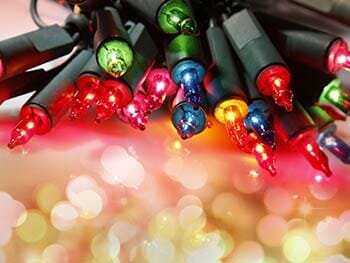
This time of year, newspapers and social media post photos of homes lavishly decorated and lit for the Christmas season. Homeowners associations often sponsor decorating contests, drawing sightseers to “oooh” and “aahhh” as they slowly wind through neighborhood roads illuminated by all manner of electric light displays. What doesn’t always make the news are the catastrophes caused by dangerously manufactured or damaged Christmas decorations. Even modest apartment displays can be the cause of tragic accidents when consumers unwittingly use defective products.
Whether you are decorating with newly purchased supplies or you have retrieved some old ones from that box over the garage or in Grandma’s dusty attic, you should check them out from a safety standpoint before you deck the halls. Observe these safety tips published by the Consumer Product Safety Commission (CPSC):
- Make sure all lights have been tested for safety by a recognized testing laboratory, like UL; use only lights that have fused plugs.
- Check each set of lights for broken or cracked sockets, frayed wires or loose connections.
- If a bulb has burned out, replace it with one of the same wattage.
- Don’t use more than three sets of lights on one extension cord and make sure the extension cord was intended to carry that load.
- Make sure any lights used outdoors were certified for outdoor use.
- If the power lines in your neighborhood are not underground, stay away from the utility poles and lines feeding your home.
- Don’t use nails or tacks to attach outdoor lights to trees or your house.
- Don’t leave lights on all night; turn them off if you leave the house. The lights could short out and start a fire.
- Outdoor lights should be plugged into circuits protected by ground fault circuit interrupters (GFCIs).
Even if the Christmas decorations appear to be in good condition and you are careful about their use, your family could be endangered if they were dangerously designed. The CPSC investigates complaints about such products, each year issuing numerous recalls in an effort to ensure holiday safety. Some, such as those below, are for outdoor products:
- The CPSC issued a recall in July 2013 for 10-piece light sets used to illuminate walkways during the Christmas holiday season. Sold exclusively at Big Lots, the sets contain ten 11-inch tall light stakes with a 5-inch colored bulb on each. The stakes are connected by a 15-foot long cord. The problem is, the lights use plated steel conductors and have a plastic coating and components that are not flame retardant, posing a fire hazard. That’s not the way you want to illuminate your sidewalk.
- On July 12, 2012, they recalled a set of 200 Mini Lights sold at Family Dollar stores in 2011 and 2012. The lights, which could be used either indoors or outdoors, presented a potential fire and electric shock hazard.
- Brookfield entry way decorating sets sold by True Value Hardware stores were recalled on December 23, 2011. The sets include two green artificial 48-inch trees in black metal vases, one green 24-inch wide wreath and one green 9-foot long garland. The wreath has battery-powered white lights. The trees and the garland plug into wall outlets. The battery box can overheat.
Indoor Christmas decorations also routinely undergo scrutiny and have been the subject of recalls:
- In February of this year, the CPSC recalled some multi-colored musical Christmas lights made in China. The 100-light sets twinkle as eight Christmas carols play. This sounds like fun, but the fire and shock hazards due to the string’s overheating could certainly put a damper on holiday festivities. These were manufactured by the Pepe Ganga Corporation.
- In December of 2013, the U.S. Consumer Product Safety Commission worked with Menards to recall pre-lit Christmas trees because the tree’s light strings can overheat and melt, posing fire, burn, and shock hazards to consumers. If you’ve been affected by such incidents, consulting with a Baltimore burn injury lawyer can provide guidance on potential legal remedies. The recall involved the Twinkling Pine pre-lit artificial Christmas trees sold under the Enchanted Forest brand and was sold exclusively at Menards.
- On February 28, 2013, the CPSC recalled Balsam Hill pre-lit trees because the tree’s remote control receiver box overheated and melted. These were no cheapies: they sold online for between $1,250 and $3,550.
- Bethlehem Lights pre-lit trees sold exclusively by QVC were recalled on December 26, 2012, because the tree base can overheat, posing a fire hazard.
- Even non-electric decorations can be hazardous: Various resin decorations sold in Papyrus stores were recalled on December 20, 2012. They included Christmas tree ornaments and decorative home accessories. The presence of aspergillus mold spores was discovered on the products, posing a risk of respiratory or other infections in individuals with chronic health problems or those with impaired immune systems.
Please take the time to check your own Christmas decorations against these descriptions. If you own another product which has caused problems and seems to be dangerous, you should report it to the CPSC. And, by all means, if you have a product-related injury you should let them know so an investigation can be made and other consumers can be protected. Go online to www.SaferProducts.gov or call CPSC’s Hotline at (800) 638-2772.
At the Law Offices of Steven H. Heisler, we want your holidays to be merry and bright. But if they are darkened by an accident involving a defectively designed or poorly manufactured product, we can help. Contact us at (410) 625-4878.
